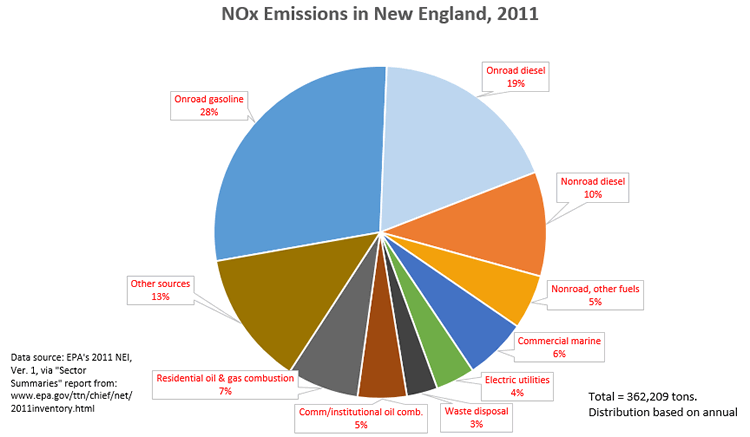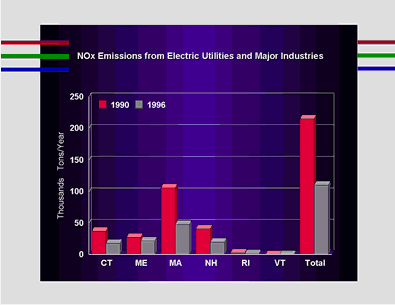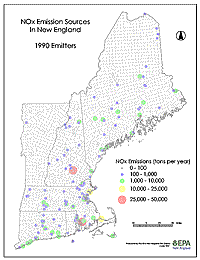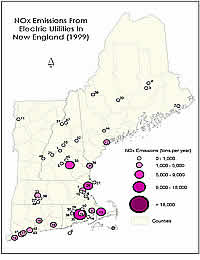Why Is Nox Regulated Under The Clean Air Act?
Nitrogen Oxides (NOx) Control Regulations
This webpage provides a brief clarification of nitrogen oxide (NOx) emissions and general information most the air quality programs in New England that focus on reducing NOx.
Nitrogen Oxides are a family of poisonous, highly reactive gases. These gases form when fuel is burned at high temperatures. NOx pollution is emitted by automobiles, trucks and various non-road vehicles (e.1000., construction equipment, boats, etc.) too as industrial sources such as power plants, industrial boilers, cement kilns, and turbines. NOx often appears as a brownish gas. Information technology is a strong oxidizing agent and plays a major role in the atmospheric reactions with volatile organic compounds (VOC) that produce ozone (smog) on hot summer days. The pie nautical chart below shows how NOx emissions in New England were distributed among the diverse sectors in 2002.

The New England states take adopted regulations that require many facilities to reduce NOx emissions. These emissions can exist reduced by making process changes (such as modifications to the combustion procedure) or by installing air pollution control equipment (such equally selective not-catalytic reduction (SNCR) or selective catalytic reduction (SCR)).
The regulations were developed by the New England states to be consistent with three separate programs that reduce NOx emissions:
- NOx Reasonably Available Control Engineering science (RACT)
- Ozone Transport Region NOx Cap and assart Trading Plan
- EPA's Ozone Transport NOx SIP Call
NOx Reasonably Bachelor Command Technology (RACT)
The Clean Air Deed Amendments of 1990 required major stationary sources of NOx to install and operate reasonably available command technology (RACT) by May 31, 1995. All of the New England States take developed and implemented NOx RACT regulations. Region-wide, these regulations have reduced NOx from stationary sources by more than fifty% from 1990 levels. Below is a bar graph comparison of 1990 and 1996 NOx emissions from big stationary sources. (Click on the graphic below to get a larger view.)

To see a geographical representation of where the largest NOx sources in New England based on 1990 emissions were located, click the map link beneath. Pointing your mouse at the emission points on the map volition betoken the source name and the bodily amount of NOx emitted in 1990.

Click the paradigm above to view a more detailed map* of NOx Emission Sources in New England.
State NOx regulations accept to run into a level of stringency we telephone call RACT, or Reasonably Available Control Technology. RACT is divers equally the lowest level of emissions that can be achieved taking into business relationship technical and economic considerations. EPA provides guidance on RACT in documents called Control Technique Guidelines. EPA reviews and comments on proposed State regulations during the state'southward public hearing procedure to ensure that these rules see RACT and will reach the emissions reduction projected. One time the land has adopted the NOx rule, EPA approves the rule into the land's Land Implementation Programme (SIP). The state's NOx dominion and then becomes federally enforceable.
For more information on the EPA's NOx RACT programme click here.
Meridian of Page
Ozone Send Region (OTR) NOx Cap and Allowance Trading Programme:
The Ozone Send Region includes Maine, New Hampshire, Vermont, Massachusetts, Connecticut, Rhode Isle, New York, New Jersey, Pennsylvania, Maryland, Delaware, the northern counties of Virginia, and the Commune of Columbia and is headed upwards by the Ozone Transport Commission (OTC). Leave The New England states take actively participated in the OTC's development of a regional NOx cap and trade program being implemented to accost the regional transport.
In September 1994, the OTC states adult a memorandum of understanding (MOU) to reach regional emission reductions of NOx. By signing the MOU, us committed to develop and prefer regulations that will reduce region-wide NOx emissions by more than than 317,000 tons per yr by 2003 through a NOx cap and allowance trading program.
Generally, the OTC program requires large electricity generating and industrial NOx sources in southern New England to meet a NOx cap equivalent to the sources reducing 55% - 65% from a 1990 baseline, or emitting at a charge per unit no greater than 0.20 pounds of NOx per million Btu of heat input (lb NOx/mmBtu), during the period between May 1 and Oct 1 (the ozone season). The program began in New Hampshire, Massachusetts, Rhode Island, and Connecticut on May 1, 1999. In northern New England, the program caps NOx emissions at the large sources at a level equivalent to NOx RACT.
Emissions from utilities in New England accept decreased 57% from 1990 to 1996 as a outcome of the OTC NOx Cap and trade program. The 1990, 1996 and 1999 NOx emissions from utilities in New England are graphed in a bar chart for comparison. The 1999 emissions are also represented geographically on the map link below.

Click the image to a higher place to view a more than detailed map* of NOx emissions from electrical utilities in New England.
First in the ozone flavor of 2003, the OTC program becomes more stringent requiring sources in southern New England to see a cap equivalent to the sources reducing seasonal emissions by 65% - 75% from a 1990 baseline, or emitting NOx at a rate no greater than 0.15 lb NOx/mmBtu of heat input. Similar provisions are also being implemented through the EPA's NOx SIP Call over a larger geographical area.
The 1999 and 2003 OTC MOU limits are not automatically effective. They will only become effective upon adoption of regulations past each state. Subsequently, they will need to be approved by EPA into the SIPs. To appointment, New Hampshire, Massachusetts, Rhode Island, and Connecticut have finalized NOx cap and trade regulations which were approved past EPA New England. For additional data on the OTC program, every bit well every bit the EPA NOx SIP, please visit EPA's Make clean Air Market Programs: NOx Trading Programs.
Top of Page
EPA'due south Ozone Ship NOx SIP Call:
The Ozone Transport Region (OTR) NOx Cap and Allowance Trading Program addresses emissions in the northeast states, however, long-range ozone transport involves large NOx emission sources outside of the OTR. The map link below shows how the l peak SO2 and NOx sources compare to the top v sources in New England Map. This map is based on information from the Acid Pelting Program which also served as a model for the Ozone Transport NOx SIP Call.
Through a two-year effort known as the Ozone Transport Assessment Group (OTAG), EPA worked in partnership with the 37 eastern-most states and the District of Columbia, industry representatives, and environmental groups to address ozone transport. OTAG identified and evaluated flexible and cost-effective strategies for reducing long-range send of ozone and ozone precursors. Based on the OTAG process, on Oct 27, 1998, EPA published a last rulemaking action (63 FR 57356). The rulemaking, commonly referred to as the NOx SIP Call, required 22 eastern states and the District of Columbia to submit state implementation plans (SIPs) that set statewide ozone season NOx budgets which would reduce emissions of NOx. By reducing emissions of NOx, the actions directed by these plans will subtract the ship of ozone across state boundaries in the eastern half of the Usa.
A number of parties, including states, industry and labor groups, challenged the NOx SIP Call rule. On March three, 2000, the D.C. Circuit ruled in favor of EPA on all major elements of the NOx SIP Call, nevertheless, the court did remand four small-scale issues, related to geography and definitions, back to the EPA. Based on the court ruling, EPA separated the NOx SIP Phone call into two separate implementation phases. Phase I includes implementation of the major elements upheld by the courtroom whereas Stage Two will include implementation of those bug the court remanded back to EPA. On February 12, 2002, the EPA proposed its response to the bug remanded by the court and also proposed additional technical amendments to the NOx SIP Phone call. The link beneath connects you to the proposal which was published in the Federal Register on February 22, 2002 (67 FR 8396).
Phase I of the NOx SIP Telephone call requires the following nineteen states and the District of Columbia to submit NOx budget and trading rules by Oct 30, 2000: Alabama, Connecticut, District of Columbia, Delaware, Illinois, Indiana, Kentucky, Massachusetts, Maryland, Michigan, Northward Carolina, New Jersey, New York, Ohio, Pennsylvania, Rhode Island, Due south Carolina, Tennessee, Virginia, Wisconsin, and W Virginia.
The state NOx budgets are required to exist consistent with the statewide NOx budgets established by EPA. The EPA established the statewide NOx budgets using recommendations from OTAG on how to reduce emissions from utilities and other sources of NOx. EPA's dominion is consistent with OTAG's recommendation for utilities: an emission charge per unit limitation as low as 0.15 lbs/mmBtu or, 85% from sources 1990 emissions rate. For non-utility point sources, mobile sources, and surface area sources, OTAG recommended control of major not-utility boilers to achieve as much as 70% reduction from 1990 levels, and for federal control measures to be practical on expanse and mobile sources.
Although the EPA's NOx SIP Call does not specify which sources must reduce NOx, utilities and large non-utility point sources would be i of the most probable sources of NOx emissions reductions. Based on the emission limit for utility sources, controls such as selective catalytic reduction (SCR) and selective non-catalytic reduction (SNCR) will probable exist required on a number of units in the OTAG region. Such controls systems have been demonstrated to reduce NOx at a cost-effectiveness of less than $2,000 per ton at large sources.
As part of the SIP call find, EPA developed a regional "cap and trade" plan as a means of achieving the proposed NOx reduction levels. EPA developed a model "cap and merchandise" regulation that was included in the final rulemaking discover in October 1998. The regional cap and trade program shares many of the features of the OTC MOU programme. The New England states affected by the NOx SIP phone call have amended their OTC cap and merchandise regulations in order to come across the SIP call requirements. In improver, on September 15, 1999, EPA published a notice of proposed rulemaking in the Federal Annals, 64 FR 50036, that proposed to redistribute the NOx budgets of Connecticut, Massachusetts, and Rhode Island based on a memorandum of understanding signed past u.s.a. and EPA in Feb 1999. On December 27, 2000, EPA New England approved the NOx upkeep and trading rules submitted past CT, MA and RI (See 65 FR 81743) in accordance with the redistributed NOx budgets.
For farther information regarding the OTC NOx Budget Program and the EPA'southward NOx SIP Call please visit the EPA's Clean Air Market Programs: NOx Trading Programs website which provides farther links to the unabridged rulemaking history as well as frequently asked questions and facts.
Top of Page
Source: https://www3.epa.gov/region1/airquality/nox.html
Posted by: hermanrompairs.blogspot.com


0 Response to "Why Is Nox Regulated Under The Clean Air Act?"
Post a Comment